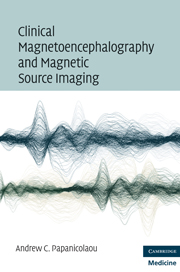Book contents
- Frontmatter
- Contents
- Contributors
- Preface
- Section 1 The method
- 1 Basic concepts
- 2 The nature and origin of magnetic signals
- 3 Recording the magnetic flux
- 4 Overview of MSI using the single equivalent current dipole (ECD) model as an example
- 5 The fundamental problems of MSI
- 6 Head models
- 7 Source models – discrete source models
- 8 Source models – distributed source models
- 9 Source models – beamformers
- 10 Pragmatic features of the clinical use of MEG/MSI
- Section 2 Spontaneous brain activity
- Section 3 Evoked magnetic fields
- Postscript: Future applications of clinical MEG
- References
- Index
2 - The nature and origin of magnetic signals
from Section 1 - The method
Published online by Cambridge University Press: 01 March 2010
- Frontmatter
- Contents
- Contributors
- Preface
- Section 1 The method
- 1 Basic concepts
- 2 The nature and origin of magnetic signals
- 3 Recording the magnetic flux
- 4 Overview of MSI using the single equivalent current dipole (ECD) model as an example
- 5 The fundamental problems of MSI
- 6 Head models
- 7 Source models – discrete source models
- 8 Source models – distributed source models
- 9 Source models – beamformers
- 10 Pragmatic features of the clinical use of MEG/MSI
- Section 2 Spontaneous brain activity
- Section 3 Evoked magnetic fields
- Postscript: Future applications of clinical MEG
- References
- Index
Summary
Signaling among neurons constitutes the most basic form of brain activity and activation imaged today and consists of electrochemical events that take place at synapses and in the axons and dendrites of neurons. Although neurotransmitter release and uptake at synapses are caused by electrical activity (i.e., action potentials), these events do not involve electrical activity directly. Dendritic and axonal currents are produced by the movement or flow of electrically charged particles, or ions, either between “electrical synapses” or within the axons or the dendrites of neurons, resulting in a physical, potentially measurable quantity, namely, an electrical current.
Were we to view directly the variation of the electrical currents at each and every cell or set of cells in the brain, referred to as current sources, and were we to plot these variations as a function of time as they sum on the scalp surface, we would obtain the familiar picture of activity we obtain with multichannel EEG. We would find that the amount of signaling the brain is producing changes from moment to moment in an apparently random manner but within certain limits.
We consider that variation is apparently random because we simply do not know what the purpose of each ripple or surge of activity is or to what end each of the intracranial sources that contribute to the signals is signaling at each point in time.
- Type
- Chapter
- Information
- Publisher: Cambridge University PressPrint publication year: 2009

